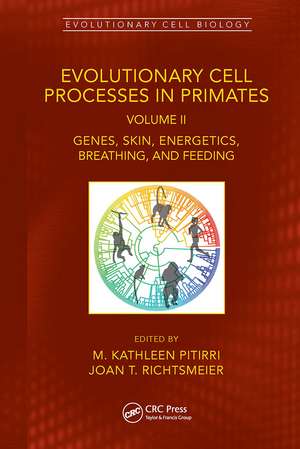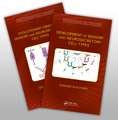Evolutionary Cell Processes in Primates: Genes, Skin, Energetics, Breathing, and Feeding, Volume II: Evolutionary Cell Biology
Editat de M. Kathleen Pitirri, Joan T. Richtsmeieren Limba Engleză Paperback – 25 sep 2023
Key Features
- Explores mechanisms underlying trait development, distribution, variation, and evolution, especially with respect to pigmentation, dental formulae, the skeleton, energetics, and temperature-related morphological variation
- Documents the advantages for anthropologists to work at the level of cells, focusing on how genes provide instructions for cells to make structure and how environment affects the behavior of cells
- Illustrates the role cell biology plays in pelage growth and pigmentation, facial morphology, melanin production in pigmentation, dental development and tooth loss, and energy expenditure
- Describes novel methodologies and techniques to analyze environment- and temperature-related influences on phenotypes
- Demonstrates how significant changes in life history occur at the level of the cell
Related Titles
Bianchi, L. Developmental Neurobiology (ISBN 978-0-8153-4482-7)
King, G. R. Primate Behavior and Human Origins (ISBN 978-1-138-85317-1)
Rhys Evans, P. H. The Waterside Ape: An Alternate Account of Human Evolution (ISBN 978-0-367-14548-4)
| Toate formatele și edițiile | Preț | Express |
|---|---|---|
| Paperback (3) | 314.24 lei 6-8 săpt. | |
| CRC Press – 25 sep 2023 | 314.24 lei 6-8 săpt. | |
| CRC Press – 30 aug 2024 | 455.12 lei 6-8 săpt. | |
| CRC Press – 25 sep 2023 | 499.40 lei 6-8 săpt. | |
| Hardback (2) | 705.53 lei 6-8 săpt. | |
| CRC Press – 29 sep 2021 | 705.53 lei 6-8 săpt. | |
| CRC Press – 29 sep 2021 | 785.75 lei 6-8 săpt. |
Preț: 314.24 lei
Preț vechi: 365.10 lei
-14% Nou
Puncte Express: 471
Preț estimativ în valută:
60.14€ • 62.55$ • 49.65£
60.14€ • 62.55$ • 49.65£
Carte tipărită la comandă
Livrare economică 14-28 aprilie
Preluare comenzi: 021 569.72.76
Specificații
ISBN-13: 9781032072784
ISBN-10: 1032072784
Pagini: 260
Ilustrații: 6 Tables, black and white; 6 Line drawings, color; 9 Line drawings, black and white; 13 Halftones, color; 19 Illustrations, color; 9 Illustrations, black and white
Dimensiuni: 156 x 234 mm
Greutate: 0.54 kg
Ediția:1
Editura: CRC Press
Colecția CRC Press
Seria Evolutionary Cell Biology
ISBN-10: 1032072784
Pagini: 260
Ilustrații: 6 Tables, black and white; 6 Line drawings, color; 9 Line drawings, black and white; 13 Halftones, color; 19 Illustrations, color; 9 Illustrations, black and white
Dimensiuni: 156 x 234 mm
Greutate: 0.54 kg
Ediția:1
Editura: CRC Press
Colecția CRC Press
Seria Evolutionary Cell Biology
Public țintă
Postgraduate and ProfessionalCuprins
Volume 2 Evolutionary Cell Processes in Primates: Genes, Skin, Energetics, Breathing, and Feeding
Chapter 1 Molecular and cellular processes of pelage pigmentation and growth in primate evolution
Elizabeth Tapanes, Jason M. Kamilar, and Brenda J. Bradley
Chapter 2 Cell processes and key genes in the evolution of pigmentation variation in humans
Heather Norton
Chapter 3 Cell processes underpinning the evolution of primate dental form and formula
Cassy M. Appelt, Elsa M. Van Ankum, Denver F. Marchiori, and Julia C. Boughner
Chapter 4 Gene regulatory processes in the development and evolution of primate skeletal traits
Genevieve Housman
Chapter 5 Processes that generate modularity in the mammalian skull: implications for primate evolution
Nandini Singh
Chapter 6 Brown adipose tissue, nonshivering thermogenesis, and energy availability
Maureen Devlin
Chapter 7 Interaction between environmental temperature and craniofacial morphology in human evolution: A focus on upper airways
Laura Maréchal and Yann Heuzé
Chapter 8 Evolution and development of the nasal airways in primates: the influence of eye size and position on chondrogenesis and ossification of the nasal skeleton
Timothy D. Smith and Valerie B. DeLeon
Chapter 9 Stem Cells in Primate Evolution
Emily Durham and M. Kathleen Pitirri
Chapter 1 Molecular and cellular processes of pelage pigmentation and growth in primate evolution
Elizabeth Tapanes, Jason M. Kamilar, and Brenda J. Bradley
Chapter 2 Cell processes and key genes in the evolution of pigmentation variation in humans
Heather Norton
Chapter 3 Cell processes underpinning the evolution of primate dental form and formula
Cassy M. Appelt, Elsa M. Van Ankum, Denver F. Marchiori, and Julia C. Boughner
Chapter 4 Gene regulatory processes in the development and evolution of primate skeletal traits
Genevieve Housman
Chapter 5 Processes that generate modularity in the mammalian skull: implications for primate evolution
Nandini Singh
Chapter 6 Brown adipose tissue, nonshivering thermogenesis, and energy availability
Maureen Devlin
Chapter 7 Interaction between environmental temperature and craniofacial morphology in human evolution: A focus on upper airways
Laura Maréchal and Yann Heuzé
Chapter 8 Evolution and development of the nasal airways in primates: the influence of eye size and position on chondrogenesis and ossification of the nasal skeleton
Timothy D. Smith and Valerie B. DeLeon
Chapter 9 Stem Cells in Primate Evolution
Emily Durham and M. Kathleen Pitirri
Notă biografică
M. Kathleen Pitirri, PhD is a Postdoctoral Scholar in the Department of Anthropology at Pennsylvania State University. She received her PhD from the University of Toronto in 2019 where she studied primate evolution, focusing specifically on the taxonomic, ontogenetic, and functional basis of mandibular shape variation in living and fossil primates. During her PhD research, Dr. Pitirri developed a novel methodology for studying shape variation of mandibular fragments that are part of the primate fossil record. She found a strong relationship between the shape of the mandibular corpus and molar crypt formation in great apes, suggesting that mandibular shape is linked to an extended period of development in great apes, representing an important evolutionary shift in primates. Upon joining the Richtsmeier Lab, Dr. Pitirri began using mouse models to study the cellular mechanisms involved in transferring information from the genotype to the phenotype. The changes observed in mouse models can be used to interpret the cellular basis for changes observed in skull shape in primates because mechanisms that build the craniofacial skeleton during development also drive variation in disease and evolution. Dr. Pitirri is particularly interested in the evolutionary consequences of change in developmental processes driving the patterning of cellular activities involved in embryogenesis of skull bones, the role of the chondrocranium in skull development, and the genetic pathways regulating the relationship between tooth and bone formation during embryonic development.
Joan Richtsmeier is Distinguished Professor of Anthropology at the Pennsylvania State University. She received her PhD from Northwestern University in 1985 and joined the faculty of the Department of Cell Biology and Anatomy, Johns Hopkins University School of Medicine in 1986. There, she focused on establishing new quantitative methods for studying change in biological shape through time, especially in primates, with Professor Subhash Lele. In 1999 she became the 55thwoman to achieve the rank of Professor at Johns Hopkins University School of Medicine since the school opened in 1893. In 2000, Dr. Richtsmeier moved her lab to the Pennsylvania State University. There, her focus turned to joining developmental biology with evolutionary biology, and with collaborators and students, she has worked to integrate the study of mouse models carrying known genetic variants with understanding the biological basis of patterns of evolutionary change. She is particularly interested in early formation of the chondrocranium and how and why cells decide to become osteoblasts and make bone. Dr. Richtsmeier was elected Fellow of the American Association of Anatomists (AAA) in 2018, received the Henry Gray Scientific Achievement Award of the AAA in 2019, and the David Bixler Excellence in Craniofacial Research Award of the Society for Craniofacial Genetics and Developmental Biology in 2019. She was elected Fellow of the AAAS (Section on Biological Sciences) in 2020. Her work is supported by grants from the National Science Foundation, the National Institutes of Health, and the Wellcome Trust.
Joan Richtsmeier is Distinguished Professor of Anthropology at the Pennsylvania State University. She received her PhD from Northwestern University in 1985 and joined the faculty of the Department of Cell Biology and Anatomy, Johns Hopkins University School of Medicine in 1986. There, she focused on establishing new quantitative methods for studying change in biological shape through time, especially in primates, with Professor Subhash Lele. In 1999 she became the 55thwoman to achieve the rank of Professor at Johns Hopkins University School of Medicine since the school opened in 1893. In 2000, Dr. Richtsmeier moved her lab to the Pennsylvania State University. There, her focus turned to joining developmental biology with evolutionary biology, and with collaborators and students, she has worked to integrate the study of mouse models carrying known genetic variants with understanding the biological basis of patterns of evolutionary change. She is particularly interested in early formation of the chondrocranium and how and why cells decide to become osteoblasts and make bone. Dr. Richtsmeier was elected Fellow of the American Association of Anatomists (AAA) in 2018, received the Henry Gray Scientific Achievement Award of the AAA in 2019, and the David Bixler Excellence in Craniofacial Research Award of the Society for Craniofacial Genetics and Developmental Biology in 2019. She was elected Fellow of the AAAS (Section on Biological Sciences) in 2020. Her work is supported by grants from the National Science Foundation, the National Institutes of Health, and the Wellcome Trust.
Recenzii
" … these volumes will be of broad interest to biological anthropologists and demonstrates that cell biology can be incorporated into the study of any biological trait. In addition to the wide variety of complex traits covered by the authors, an equally impressive range of cellular and molecular concepts and techniques are included. The chapters within these volumes provide an excellent survey [and will be] a valuable resource for biological anthropologists for year to come." K. E. Willmore – American Journal of Biological Anthropology.
Descriere
This volume demonstrates the role of cellular mechanisms in the production of specializations defining primates with respect to locomotion, energetics and diet. We highlight how genetic analysis, visualization of cells and tissues, and merging Evo-Devo with cell biology combine to answer questions central to understanding primate evolution.















